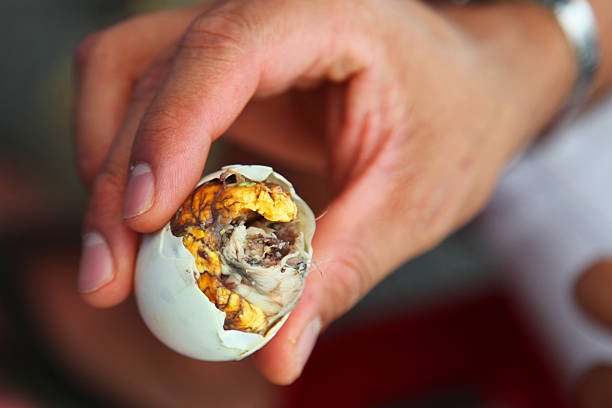Delicacies come in various forms, and what’s considered strange or exotic in one culture might be a beloved treat in another. The world is a treasure trove of unusual and intriguing foods that can both challenge and delight your taste buds.
1. Balut (Philippines)
Balut is a Filipino delicacy that often raises eyebrows. It’s a fertilized duck embryo that’s boiled and typically eaten from the shell. While the sight of a partially developed duckling can be unsettling, many people find its flavor to be a unique combination of rich and savory.
2. Hákarl (Iceland)
Hákarl is an Icelandic specialty made from fermented shark meat. The process involves burying the shark underground for several weeks, allowing it to ferment. The result is an acquired taste, with an intensely strong odor and a pungent, ammonia-like flavor.
3. Casu Marzu (Sardinia, Italy)
Casu marzu is a traditional Sardinian cheese, known for its live insect larvae. It’s made from pecorino cheese that’s intentionally infested with cheese fly larvae. The larvae break down the cheese’s fats, giving it a soft and spreadable texture. Some consider it a delicacy, while others might find the idea a bit hard to digest.
4. Century Egg (China)
Century eggs, also known as preserved eggs, are a Chinese delicacy made by preserving duck, chicken, or quail eggs in a mixture of clay, ash, salt, quicklime, and rice straw. The eggs undergo a chemical transformation during the process, resulting in a gelatinous texture and a distinct flavor that’s both rich and slightly sulfurous.
5. Surströmming (Sweden)
Surströmming is a Swedish dish of fermented herring. The fermentation process produces a strong odor that can be challenging for some to endure. When served, surströmming is typically accompanied by flatbread, potatoes, onions, and sour cream.
6. Rocky Mountain Oysters (United States)
Rocky Mountain oysters aren’t actually oysters. They are bull or bison testicles that are typically battered and fried. This American delicacy is enjoyed by many and is often served at local festivals and gatherings in the Rocky Mountain region.
7. Tuna Eyeball (Japan)
Tuna eyeballs might not be the first item on your list, but in Japan, they’re considered a delicacy. The eyeballs are typically seasoned and simmered, resulting in a dish with a gelatinous texture and a mildly fishy taste.
8. Kopi Luwak (Indonesia)
Kopi Luwak, often referred to as civet coffee, is made from coffee beans that have been consumed and excreted by a civet, a small mammal. The beans are collected from the civet’s feces, thoroughly cleaned, and then roasted to make one of the most expensive coffees in the world.
9. Fugu (Japan)
Fugu is a Japanese pufferfish that contains a deadly toxin. To prepare it safely, chefs must undergo rigorous training and certification. The resulting dish is a delicacy known for its subtle flavor and unique texture.
10. Khash (Armenia and Middle East)
Khash is a traditional Armenian and Middle Eastern dish made from boiled cow’s or sheep’s feet. The dish is known for its gelatinous texture and is often eaten during the winter months. It’s traditionally enjoyed with flatbread, garlic, and radishes.
11. Stargazey Pie (United Kingdom)
Stargazey pie is a unique British dish featuring fish heads that protrude through the pastry crust, appearing as if they are gazing at the stars. It’s a quirky and visually striking dish that has its roots in a Cornish legend.
12. Snake Wine (Vietnam)
Snake wine is a Vietnamese delicacy that involves steeping a venomous snake, often a cobra, in rice wine. The belief is that the venom is neutralized by the alcohol, making it safe to drink. It’s considered an aphrodisiac and is often sipped for its supposed health benefits.
13. Sannakji (South Korea)
Sannakji is a South Korean dish featuring live octopus that is cut into small pieces and served immediately. The tentacles continue to squirm on the plate, creating a dining experience that’s both thrilling and slightly unsettling.
14. Beondegi (South Korea)
Beondegi are steamed or boiled silkworm pupae, a popular street food in South Korea. They are often seasoned with spices and enjoyed for their unique texture and flavor.
15. Tiet Canh (Vietnam)
Tiet Canh is a Vietnamese dish made from fresh duck or chicken blood. It’s typically prepared by mixing the blood with fish sauce, fresh herbs, and roasted peanuts. The dish offers a balance of flavors and textures.
16. Escamoles (Mexico)
Escamoles are often referred to as “insect caviar” and are the edible larvae of a species of ants. They have a nutty and buttery flavor and are considered a delicacy in Mexican cuisine.
17. Haggis (Scotland)
Haggis is a traditional Scottish dish made from the heart, liver, and lungs of a sheep, minced with onions, oatmeal, suet, and spices. It’s then encased in a sheep’s stomach and simmered. While the ingredients may seem unusual, haggis is a beloved and iconic Scottish dish.
18. Tong Zi Dan (China)
Tong Zi Dan, also known as virgin boy eggs, is a Chinese dish made by boiling eggs in the urine of young boys. It’s a traditional delicacy in Dongyang, China. The dish is believed to have health benefits, although it is not without controversy.
19. Yak Penis (Tibet)
In Tibet, yak is a staple of the diet, and that includes nearly every part of the animal, even the reproductive organs. Yak penis is considered a delicacy and is often enjoyed in various dishes, from stews to skewers.
20. Witchetty Grub (Australia)
Witchetty grubs are the larvae of cossid wood moths and are a traditional Aboriginal food source in Australia. They are often eaten raw or lightly cooked and are a valuable protein source in the Australian outback.
While these delicacies might seem strange or unconventional to some, they represent the rich tapestry of global culinary traditions. They showcase the adventurous spirit of food lovers and the diverse flavors that can be discovered when we step outside our culinary comfort zones.
